Despite being the second smallest state -after Rhode Island- Delaware has one of the richest wildlife scenes you’ll ever see, especially when it comes to birds. There are arguments about the exact number of bird species in Delaware, but it’s somewhere between 390 and 420!
The small state boasts a lot of tourist attractions, ranging from fine ancient museums and mansions to pristine beaches. In addition to that, you’d be missing a lot if you didn’t take a look at the state’s abundant wildlife scene while you’re there.
Since it’s not possible for you to see all 420 species of birds there, we made you a list of 25 must-see birds in Delaware. From bright, colorful birds to common backyard birds, check out the wonderful variety that Delaware has to offer!
Red Birds in Delaware
Northern Cardinal

- Scientific Name: Cardinalis Cardinalis
- Length: 8.3 – 9 in.
- Weight: 1.5 – 1.7 oz.
- Wingspan: 9.8 – 12.2 in.
The Northern Cardinals are probably the most common and popular backyard birds bird you’ll see in Delaware. It’s abundant in the eastern half of the U.S and a year-long resident of Delaware.
Males are plump with unmistakable vivid red plumage, while females have duller colors; brown with orange hues. Both have distinctive red crests, black masks, and orange-reddish long tails.
Their short conical bills are perfect for chewing seeds; sunflower seeds, peanut, and corn. They’ll also feed on fruits like grapes and berries when available. It’s said that fruits are the reason for their vivid color, because of carotenoids.
Northern Cardinals are known to be aggressive birds during their breeding season. A male will be so overprotective of its territory that it’s been known to attack its own reflection!
Ruby-Throated Hummingbird

- Scientific Name: Archilochus Colubris
- Length: 2.8 – 3.5 in.
- Weight: 0.1 – 0.2 oz.
- Wingspan: 3 – 4.3 in.
Citizens of Delaware in hot summers, vacationers in Mexico during the winter season, these migratory birds are one of the few hummingbirds you can see in Delaware.
The adult Ruby-throated Hummingbird has beautiful plumage, with iridescent green backs and heads, with pale gray-white underparts. Their distinctive features are their ruby-colored throats and long slender bills. Females are duller than males, as they’re mostly black and white with some faint green.
This small-sized bird feeds on nectars and can be easily attracted to a feeder.
Downy Woodpecker

- Scientific Name: Dryobates Pubescens
- Length: 5.5 – 6.6 in.
- Weight: 0.7 – 1 oz.
- Wingspan: 9.9 – 11.8 in.
Despite its black and white plumage, we’ve decided to list the Downy Woodpecker under the ‘Red Birds’ category because of its conspicuous red nape, which sets it apart from other similar-looking woodpeckers.
The Downy Woodpecker is the smallest woodpecker in the United States and the most common in Delaware. You can easily draw them to your backyard using sunflower seeds, peanuts, or suets.
For a woodpecker, the Downy has a small bill. It stands erect against tree trunks, using its stiff tail for leverage, and it drums on the tree.
House Finch

- Scientific Name: Haemorhous Mexicanus
- Length: 5 – 5.5 in.
- Weight: 0.6 – 0.9 oz.
- Wingspan: 8 – 9.8 in.
The House Finch is a brave, friendly bird. It loves humans and will visit human settlements frequently. It won’t shy away from approaching humans, as well. You’ll find it in city parks, backyards, and around suburban areas.
House Finches are among the most widely distributed American bird species. Males have greyish brown plumage with red heads and bellies, while females are overall brown with visible dark brown streaks across their bellies. Their most distinctive feature is their conical grey-brown color bills. They have short grayish-brown tails as well. Besides, they’re hard to distinguish from Purple Finches.
Red-Tailed Hawk

- Scientific Name: Buteo Jamaicensis
- Length: 17.7 – 25.6 in.
- Weight: 24.3 – 51.5 oz.
- Wingspan: 44.9 – 52.4 in.
Delaware isn’t just about small hummingbirds and woodpeckers; there are some serious raptors there, the most common among them is the Red-Tailed Hawk.
The Red-Tailed Hawk is one of the most popular hawks across the US. It’s one of the largest ones, as well. They have broad rounded wings that span over nearly 50 inches, and they’re identified through their short rounded tails that are not exactly red, but more of an orangey-red hue.
Females are visibly larger than males, but both have rich brown plumage that gets darker as the wings expand and pale grey bellies. Yet, there are color variations between individuals, so you have to rely on the red tail to identify one.
Red-Bellied Woodpecker

- Scientific Name: Melanerpes Carolinus
- Length: 9.4 in.
- Weight: 2 – 3.2 oz.
- Wingspan: 13 – 16.5 in.
The name “Red-Bellied” woodpecker is quite confusing, as they have black and white wings and their bellies are actually white with a pale yellow wash! The red is on their crests and it extends from their bills back to their napes in males, and on their napes only in females. We use the red color to identify them, but it’s definitely not on their bellies.
The rest of their plumage is black barred with white, and it does look appealing. They’re easily drawn to your feeder and they’re big fans of sunflower seeds, suets, and peanuts.
They won’t shy away from other birds, even aggressive starlings. In fact, they might fend them off!
Pileated Woodpecker

- Scientific Name: Dryocopus Pileatus
- Length: 15.8 – 19.3 in.
- Weight: 8.8 – 12.2 oz.
- Wingspan: 26 – 29.5 in.
Spotting a Pileated Woodpecker would be quite an experience in Delaware. They’re huge compared to regular woodpeckers – nearly the size of a crow! – with quite distinctive calls. Pileated Woodpeckers are mostly black and white with a flaming hot red crest.
You’ll mostly find them in mature forests whacking away at dead trees looking for carpenter ants, which are the foundation of their diet. They will also visit a suet feeder when the need arises.
Blue Birds in Delaware
Blue Jay
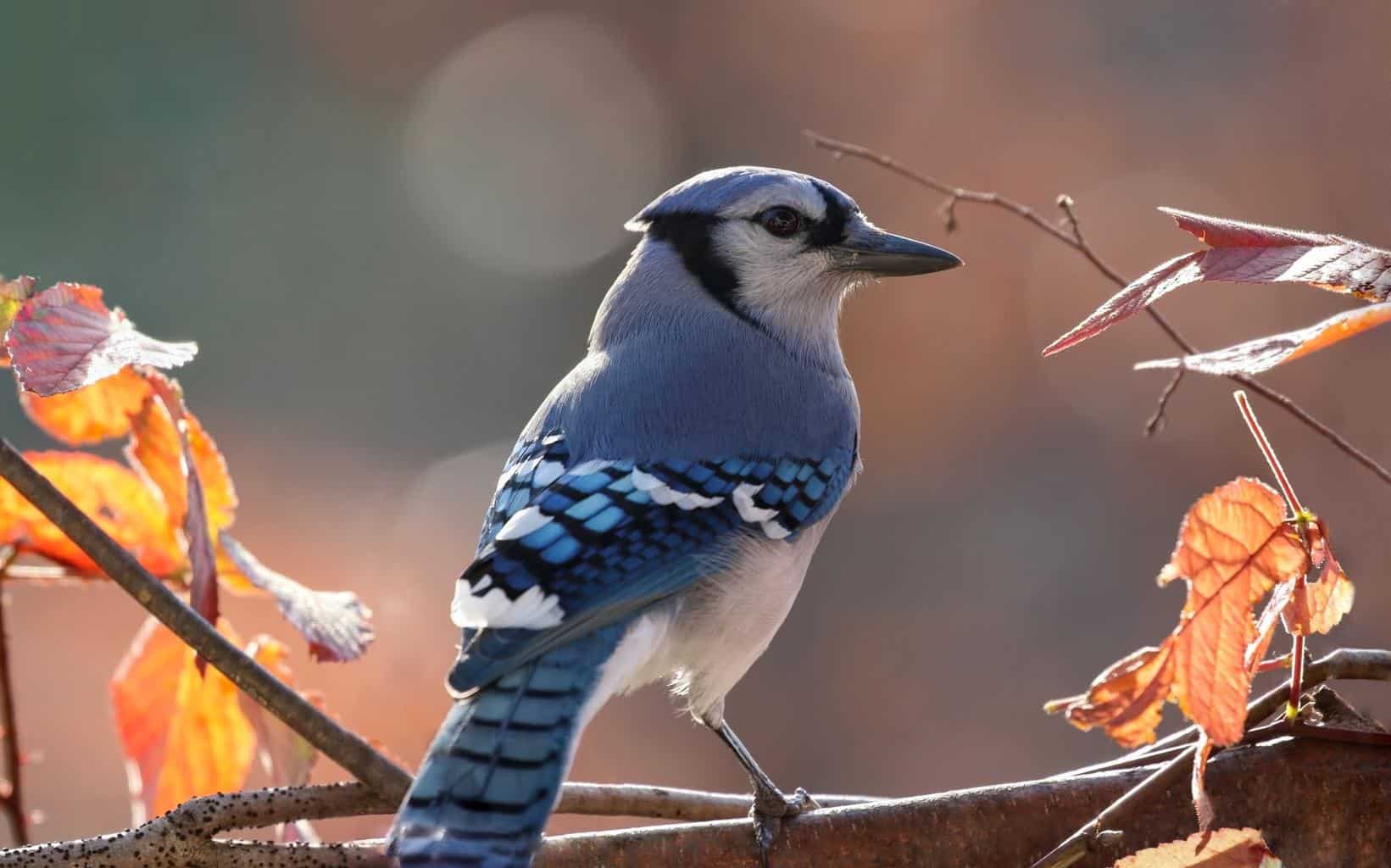
- Scientific Name: Archilochus Colubris
- Length: 9.8 – 11.8 in.
- Weight: 2.5 – 3.5 oz.
- Wingspan: 13.5 – 17 in.
Of all the bird families, the Blue Jay is one of the most beautiful birds you can spot in Delaware. Males and females are almost identical with bright blue mantles, white chests, and wings of contrasting blue, black, and white feathers, and an ample tail.
Known for being smart, adaptable, loud, and aggressive, Blue Jays produce loud calls resembling a hawk’s sound, sometimes to warn other birds or animals in the area and other times for no apparent reason.
Blue Jays eat almost everything! Their favorite meal is acorns. They’re so fond of acorns that they might store them in the ground for later. This helps in forest spreading when the Blue Jay loses their acorns.
Indigo Bunting

- Scientific Name: Passerina Cyanea
- Length: 4.7 – 5 in.
- Weight: 0.4 – 0.6 oz.
- Wingspan: 7.5 – 8.7 in.
These summer birds are native to Northern America, but they migrate towards the south in winter. Indigo Buntings have bright indigo plumage with richer blue tones on their heads and shiny silver conical bills, as the name suggests. This applies to males only, though, because females and immature males are pale brown with a few blue touches on the wings.
Interestingly, the stunning feather color of the Indigo Bunting is an optical illusion resulting from light diffraction through its feathers and not from pigment.
Male Indigo Buntings are persistent singers. They sing non-stop when they reach their nestings before the females arrive, defending their territory. They love to nest around weedy fields and brushy areas where the field meets the forest. Their flying sound resembles that of a Gold Finch.
Eastern Bluebird

- Scientific Name: Sialia Sialis
- Length: 6.3 – 8.3 in.
- Weight: 1 oz.
- Wingspan: 9.8 – 12.6 in.
The Eastern Bluebird sports a vibrant blue plumage with a rusty chest. Females are paler than males. They forage on different kinds of insects, worms, and fruits. You can attract them to your feeder with a mix of mealworms and berries or even a peanut butter mix!
Eastern Bluebirds are known for their plump bodies and erect posture. You’ll find them perching on posts, wires, and low branches, where they’re constantly on the look for prey. Whenever they spot a tasty worm or a fruiting tree, they’ll go for it.
Common Grackle
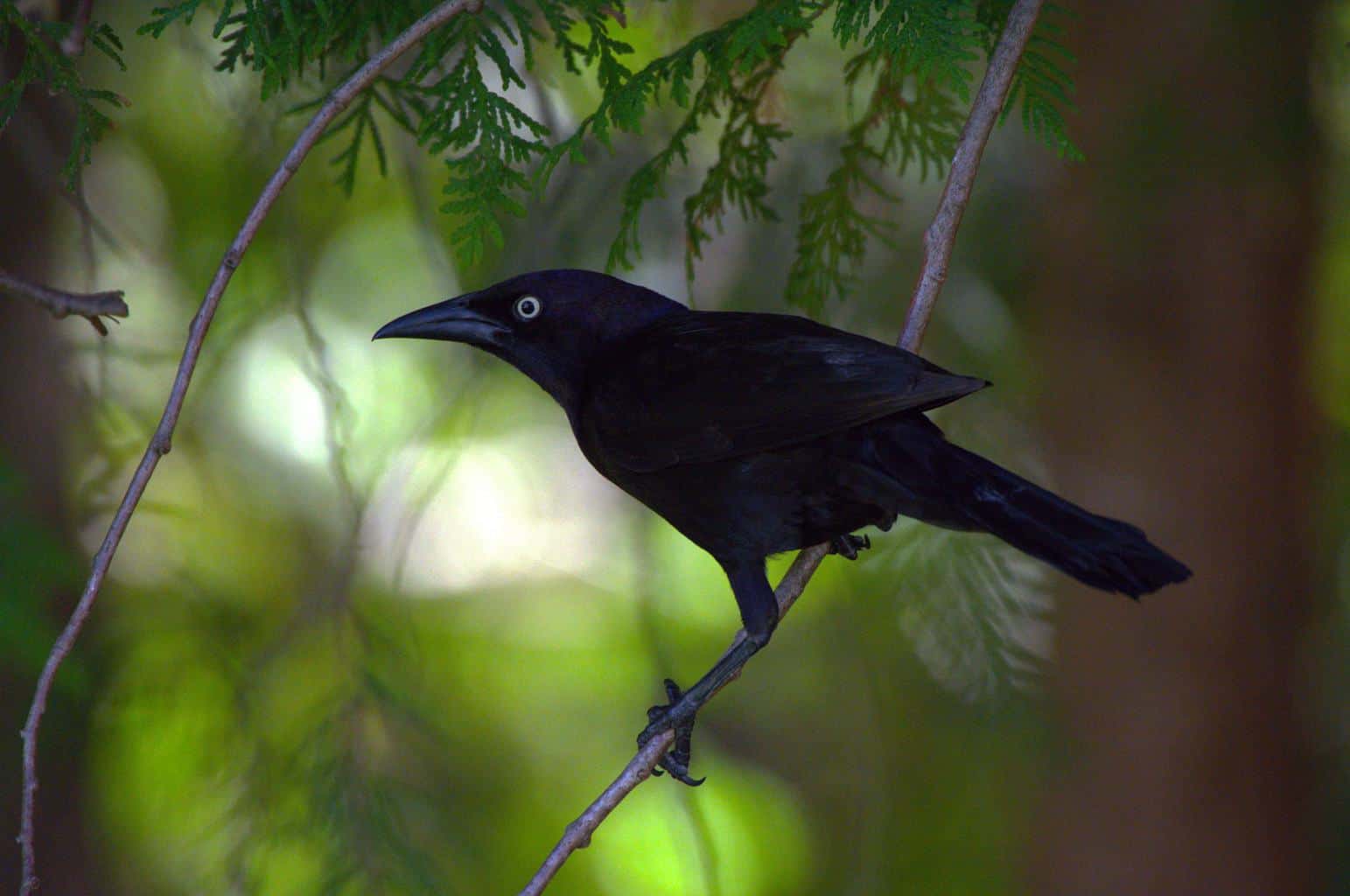
- Scientific Name: Quiscalus Quiscula
- Length: 11 – 13.4 in.
- Weight: 2.6 – 5 oz.
- Wingspan: 14.2 – 18 in.
Looking like a stretched blackbird, a Common Grackle is longer and thinner than a blackbird, with a noticeably blue head and neck. They can be a nuisance at your bird feeder, as they arrive in large flocks and scare away smaller songbirds.
A Common Grackle is mostly glossy black with a touch of green, bronze, or purple on its neck depending on the population, and has white eyes with a small black spot in them. You’ll most likely find one near a farm field as it mostly inhabits agricultural lands and lawns. They’re considered a pest on farms, where they eat the crops, especially corn.
Orange Birds in Delaware
American Robin

- Scientific Name: Turdus Migratorius
- Length: 8 – 11 in.
- Weight: 27 – 3 oz.
- Wingspan: 12.1 – 15.8 in
American Robins are among the most familiar birds across the US and in Delaware. People are so used to seeing them around in backyards, lawns, porches, and window sills that their absence is considered to be an early sign of environmental problems.
They have rusty orange breasts contrasting with their grey/brownish backs, dark feathers around their head and neck, and small yellow bills. They have strong, stocky bodies and long tails. Males have slightly brighter plumage, and they’re a bit larger. Yet, it’s hard to distinguish males and females by their appearance.
One absolutely stunning trait of the Robin is the 3-5 beautiful, distinctive sky blue color eggs the female lays during nesting, usually in pine forests.
American Robins get most of their food from the ground. They feed mostly on invertebrates like worms, snails, and insects. They also love fruits, especially berries.
Baltimore Oriole

- Scientific Name: Icterus Galbula
- Length: 6.7 – 7.5 in.
- Weight: 1 – 1.4 oz.
- Wingspan: 9 – 11.8 in
Big fans of ripe fruit, nectar, and jelly, you’ll find this familiar bird mostly on high branches and in deciduous trees. Because of their love for fruits, they’re fairly easy to draw to your lawn.
Males are medium-sized with vibrant yellow bellies and outer tail feathers. Elsewhere, it’s all black plumage. On the other hand, females have varying colorations ranging between pale brown, yellow, and orange. Because of their love of high trees, it’s more likely you’ll hear a Baltimore Oriole rather than see it. Their most common songs include a flutelike sound to protect their territory.
Yellow Birds in Delaware
American Goldfinch
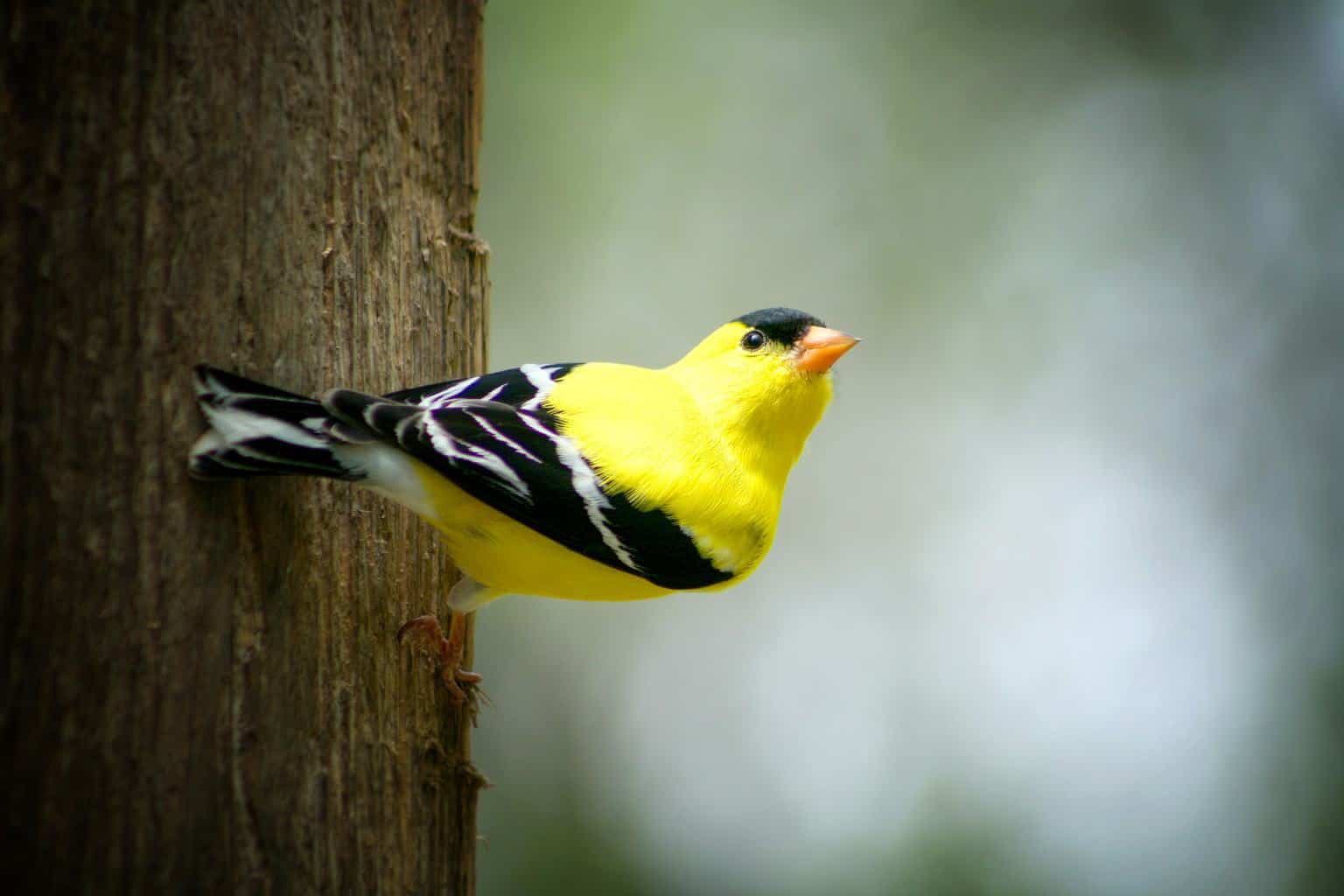
- Scientific Name: Spinus Tristis
- Length: 4.3 – 5 in.
- Weight: 0.4 – 0.7 oz.
- Wingspan: 7.5 – 8.7 in
Also known as the ‘wild canary,’ the American Goldfinch is a delight to the eye. Its plumage is mostly bright yellow with a black forehead and black wings. The males are brighter than the females. Interestingly, they only show these vibrant colors during the summer season. Winter birds turn dull, pale grayish-yellow.
American Goldfinches are strictly vegetarian. Their diet relies solely on seeds with no worms or invertebrates. This is why they breed in June and July when they wait for most plants to produce their seeds to guarantee there’s enough food for their babies.
In their non-breeding seasons, American Goldfinches flock together in an undulating pattern that grabs your attention. They’re most active during the day, and they have six different call variations.
White-Throated Sparrow
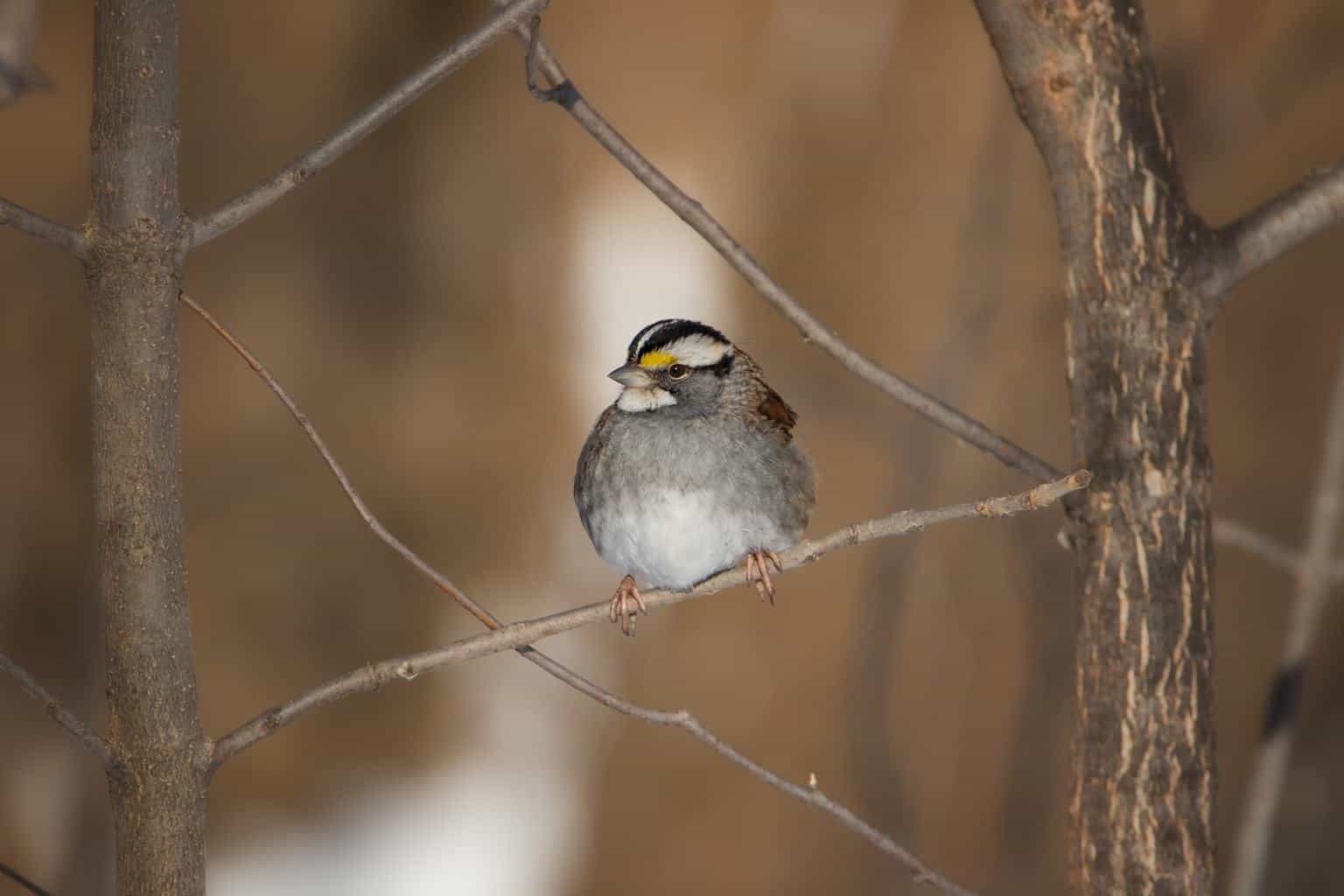
- Scientific Name: Zonotrichia Albicollis
- Length: 6.3 – 7 in.
- Weight: 0.8 – 1.1 oz.
- Wingspan: 8 – 9.1 in
The adult White-Throated Sparrow is large, plump, with a fairly long tail and short bill. Its feathers are a mix of plumage colors between brown, grey, black, and white. Its head is its most prominent feature thanks to the black stripe on each side, with a noticeable yellow mark between the bill and the eye. Because of this yellow mark, we decided to list it under this category.
White-Throated sparrows can be frequent visitors to your bird feeder because they love seeds. They also eat worms, spiders, and berries.
You can find them near the ground and in low bushes, in search of food. They mostly inhabit the edges of forests, and they nest near the ground or in small shrubs.
Carolina Wren
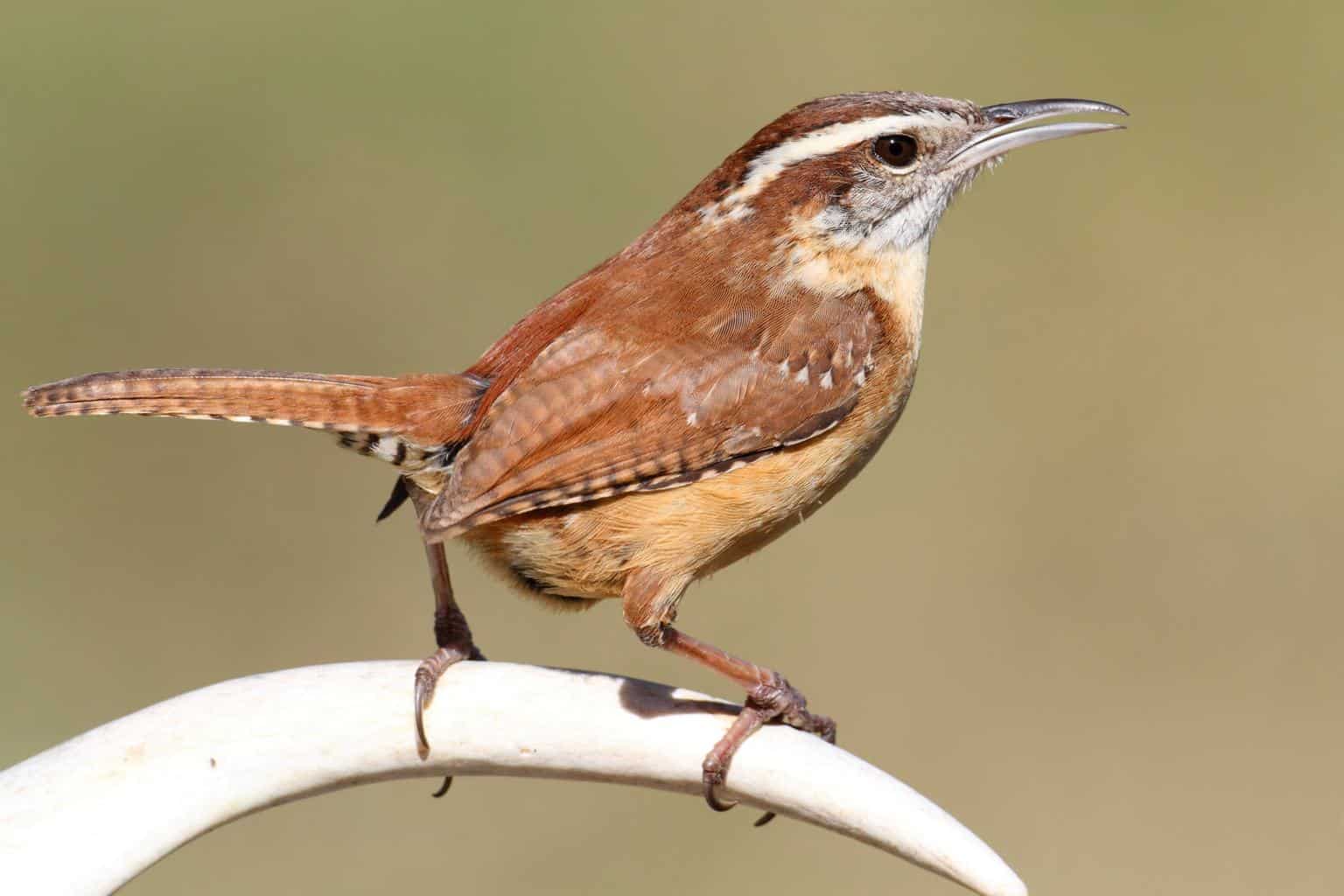
- Scientific Name: Thryothorus ludovicianus
- Length: 4.7 – 5.5 in.
- Weight: 0.5 – 0.8 oz.
- Wingspan: 11.4 in
Carolina Wrens are active birds that you’ll usually spot in your backyard, and you’ll rarely spot these acrobatic birds standing still unless they’re eating.
Usually, it’s found around shrubby thickets and dense vegetation, searching for fruits and the larvae of insects. It defends its territory with constant singing, and it’ll chase intruders away.
It is small in size, but it’s round and plump with a big head and invisible neck that gives it a bigger appearance. Males and females look similar with reddish-brown black barring their backs and pale yellow bellies. They have a remarkable white stripe above their eyebrows, and their bills are long and thin compared to their overall size.
Other Birds to Watch For in Delaware
Mourning Dove

- Scientific Name: Zenaida Macroura
- Length: 10 – 13.4 in.
- Weight: 3 – 6 oz.
- Wingspan: 17.7 in.
Mourning Doves are easily found in Delaware. These common birds have large gray wings and pale gray plumage with black spots on their tails. You can easily identify them by their pink legs and the light blue ring around their eyes. The body size of females is significantly smaller than males.
Mourning Doves rely on seeds for their diet. They don’t mind eating weed seeds, which is why farmers love them.
You can look for this medium-sized bird up in a tree or standing temporarily on a telephone wire. Otherwise, you’ll find them foraging near the ground.
Carolina Chickadee

- Scientific Name: Poecile Carolinensis
- Length: 4 – 4.7 in.
- Weight: 0.3 – 0.4 oz.
- Wingspan: 5.9 – 8 in.
Carolina Chickadees are the only type of Chickadees you can find in Delaware.
It has a remarkable black head and bib with white cheeks. The tail feathers are a combination of grey, black, brown, and beige. Despite the pale colors, the Carolina Chickadee has a pleasant appearance. They look cute! It’s probably because of their sparrow-like size.
Males and females look alike, with similar coloring and body shape, and both have nice four-noted whistles. Carolina Chickadees are common feeder birds but unlike sparrows, can’t swallow large seeds, so they’ll take one seed and go back to their nest to take their time and open it.
European Starling
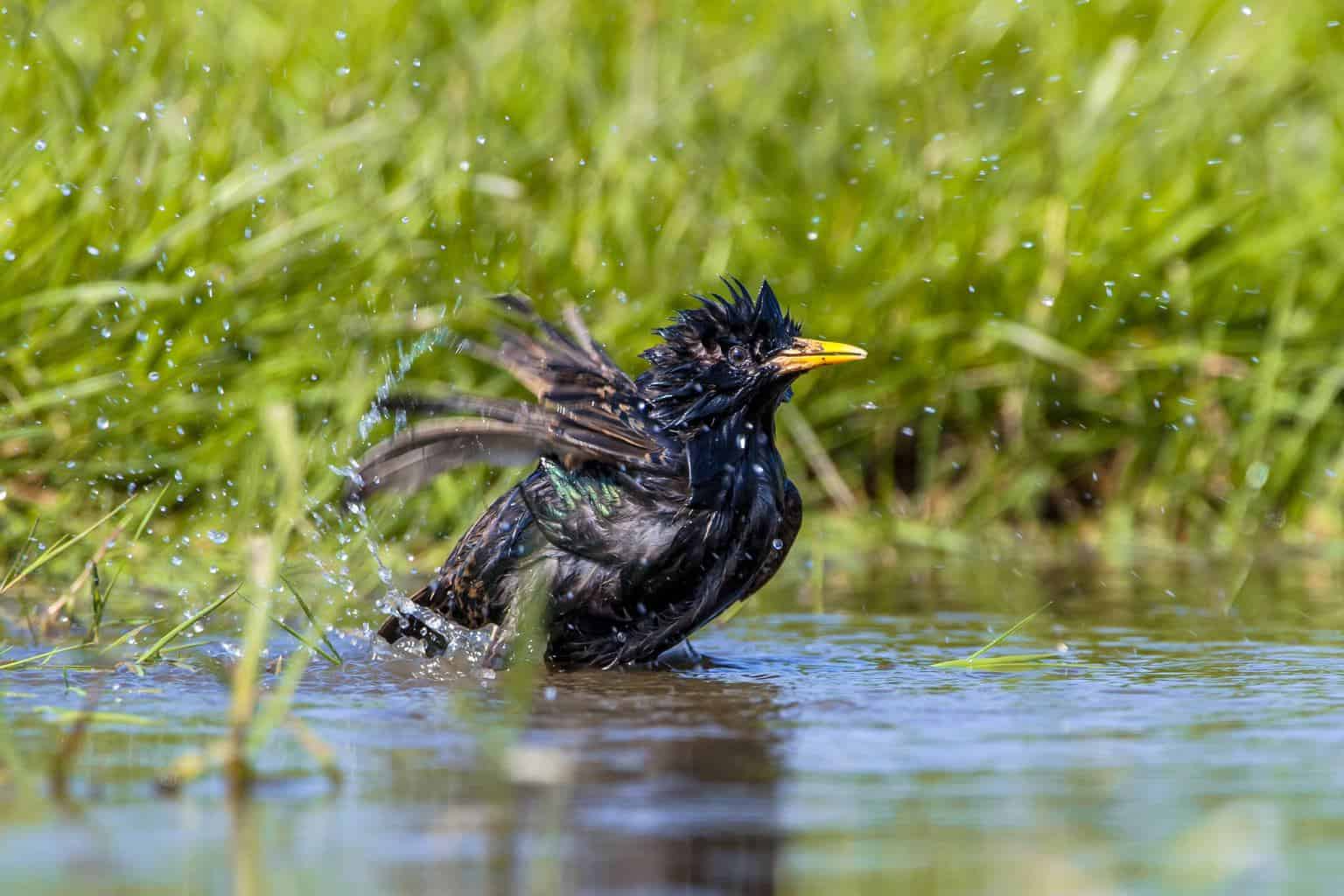
- Scientific Name:Sturnus Vulgaris
- Length: 7.9 – 9 in.
- Weight: 2 – 3.4 oz.
- Wingspan: 12.2 – 15.8 in.
Despite its fascinating color scheme that alternates between purple and green on a base of black plumage, the European Starling is one of the most hated birds. its aggressive behavior harms other birds and causes structural damage in some cases.
Non-native to the US, the European Starling is a nuisance bird that has invaded both rural and urban places in the US.
While it gets most of its favorite foods from soil; worms, insects, etc., the European Starling is a frequent visitor to bird feeders and urban parks. Bird watchers don’t appreciate these visits, though, because the Starlings scare away other birds, and they might even attack them!
Tufted Titmouse

- Scientific Name: Baeolophus Bicolor
- Length: 5.5 – 6.3 in.
- Weight: 0.6 – 0.9 oz.
- Wingspan: 8 – 10.2 in.
Commonly found in deciduous forests and sitting at bird feeders, the Tufted Titmouse is hard to miss thanks to its gleeful grey crest, big black eyes, and echoing voice.
This small-sized songbird, male and female, has a blue-ish grey back and upper body, and a yellow belly with peachy patches on both sides. They have a touch of black on their foreheads to complement their black eyes, and of course, a grey crest.
Tufted Titmice often accompany chickadees and woodpeckers during their foraging, yet they’re a bit slower but more strategic than chickadees when looking for food.
This a sedentary species, meaning they don’t migrate. In fact, mated pairs stay together in the same territory all year long.
Song Sparrow

- Scientific Name: Melospiza Melodia
- Length: 4.7 – 6.7 in.
- Weight: 0.4 – 2 oz.
- Wingspan: 7 – 9.4 in.
Little Brown Jobs (LBJs) is what birding enthusiasts call sparrows because they’re challenging to identify. They’re small, stocky, with dull brown plumage, and were originally found in the western United States. If you can’t distinguish them by sight, you’ll always be able to find them by listening for their sweet song used during mating season.
Delaware’s Song Sparrow is no different. A year-round resident that’s known for its heavily streaked head and belly with a central breast spot on the chest. The tail is long and round, while the bill is short and conical, similar to many other sparrows!
Song Sparrows love open habitats, especially ones near water surfaces. We’re talking overgrown fields, thickets, forest edges, and backyards. They’re just one of several members of the Sparrow family found in Delaware and among the most popular American songbirds.
American Crow

- Scientific Name: Melospiza Melodia
- Length: 15.8 – 21 in.
- Weight: 11.2 – 22 oz.
- Wingspan: 33.5 – 39.4 in.
You can’t miss an American Crow if you see it, thanks to its black plumage color on its entire body, from head to tail. It has a distinctive rowing-like flying motion during which you’ll see its black feathers separated to look like fingers.
The American Crow has a familiar cawing sound that they use to assemble, disperse, or signal the presence of a predator. It’s a social bird, and it’ll thrive around people, where it travels in big flocks. They are very adaptable birds and although their favorite habitat is open lands, they’ll smartly go through a garbage can looking for leftover food like no other bird!
House Sparrow

- Scientific Name: Passer Domesticus
- Length: 6 – 6.7 in.
- Weight: 0.9 – 1.1 oz.
- Wingspan: 7.5 – 9.8 in.
While sparrows, in general, are very similar in shape, the House Sparrow is a tad different. They’re overall clunkier with large heads and short tails. It’s probably because they’re native to the Middle East.
Males have brown plumage with black streaks, black bills, white cheeks, and grey crowns. Females are overall pale brown with grey underparts.
House Sparrows are an invasive species. You can find them everywhere, even at amusement parks competing with native birds for everything. They’ll fight other birds over food and nests. More often than not, they’ll win.
Gray Catbird

- Scientific Name: Dumetella Carolinensis
- Length: 8.3 – 9.5 in.
- Weight: 0.8 – 2 oz.
- Wingspan: 8.7 – 11.8 in.
A Gray Catbird is a medium size bird and one of the easiest to identify by sound. Their call resembles a cat’s ‘meow’ and hence, the name. The male uses his song to claim his territory, and he can go on singing for as long as ten minutes!
Males and females are similar with overall pale grey plumage and darker caps and tail tips. They’re about the length of a Northern Cardinal but more slender with long legs and round wings.
Northern Mockingbird

- Scientific Name: Mimus Polyglottos
- Length: 8.3 – 10.2 in.
- Weight: 1.6 – 2 oz.
- Wingspan: 12.2 – 13.8 in.
Northern Mockingbirds are impressive vocalists. They won’t stop singing while they’re standing on perches, as they love making their presence known. You’ll mostly find them on fences, high vegetation, or telephone wires.
They’re mostly grey and brown with white underparts, long tails, and short round wings. There are white spots on the wings that are particularly visible during their flights.
Wrap Up
This is just a glimpse of what types of birds you can find in Delaware! Whether you long to listen to the beautiful song of the aptly named Song Sparrow, or to glimpse a flash of the vibrant red wings of the Cardinal, the small state is worth a visit to get to watch these magnificent birds.

